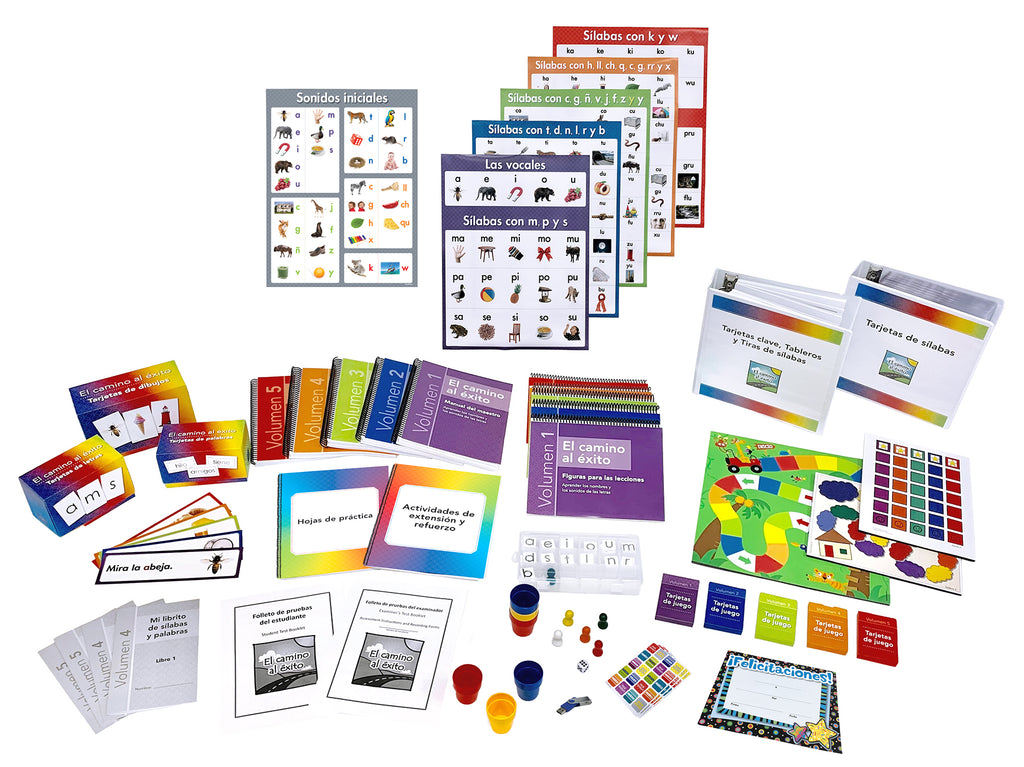- (800)279-0737
- Monday-Friday, 5:00AM-3:00PM PT M-F, 5:00a-3:00p PT

El camino al éxito is an early reading intervention for Kindergarten students learning to read in Spanish. It is designed to successfully prepare students to enter first grade reading at grade level. It offers structured, systematic instruction. Easy-to-follow and ready-to-go, El camino can be adapted for use as a beginning reading instruction or early reading intervention.
Key Features:
El camino al éxito Components:
| Product Type | Kit |
| Weight | 953.92 oz |
| Guided Reading Level | K |
| Grade Level | Kindergarten |
El camino al éxito (El camino) was developed at Metzger Elementary in Tigard, Oregon, in the fall of 2006 for students not making good progress with their core reading program. Three years earlier, Metzger had begun a Spanish literacy program for native-Spanish speakers; but the need for an intervention quickly became apparent.
Starting in fall 2006, most kindergarten students at Metzger received the 30-minute El camino intervention. In fall 2012, Metzger began a duel language immersion program in which both native-Spanish and native- English speakers were taught to read in Spanish. Most of these students also received the intervention.
Most students who have participated in the El camino program have met benchmark reading levels at the end of kindergarten, as assessed by the IDEL measures developed by the University of Oregon. They have acquired good decoding skills and are ready to enter first grade reading at grade level.
The effectiveness of El camino was evaluated using the IDEL assessment developed by the University of Oregon. Specifically, the measure Fluidez en las palabras sin sentido (FPS) was used, which measures the number of sounds a student can read in one minute. The test is administered in January and June during the kindergarten year. Scores of the following students were evaluated:
Low Risk - Reading Above Benchmark Level (35 or more sounds)
Some Risk - Reading Problems (between 25 and 34 sounds)
At Risk - Reading Problems (24 sounds or less)
Before using El camino, 89% of students were “At Risk” or at “Some Risk” for future language and reading problems.
After implementing El camino, only 7% of the students were “At Risk” or at “Some Risk.”
Two separate assessments were made. In the first assessment, the testing results collected at the end of each year were used to compare students who did not receive instruction in El camino (from fall 2003 to spring 2006) to students who received instruction (from fall 2006 to spring 2014). The graph shows the percentage of students each year who met the benchmark level (shown in green) and the percentages that were at risk for future reading problems (shown in red or yellow).
In the second assessment, the results were evaluated for only students who received instruction in El camino. For this group (158 kindergarten students), the results of the scores from winter 2007 to spring 2014 are tabulated to the right. The winter test scores were compared to the spring test scores by calculating Cohen’s d. Based on the winter scores (benchmark is 20 sounds in a minute), the students have been placed into 3 groups:
| N |
Winter Score
M |
Spring Score
M |
Actual Gain | Cohen's d | |
| Total Kindergarten | 158 | 25.83 | 67.69 | 41.86 | 1.7 |
| At Risk | 16 | 5.81 | 56.00 | 50.19 | 3.0 |
| Some Risk | 37 | 15.46 | 61.54 | 46.08 | 2.1 |
| Low Risk | 105 | 32.53 | 71.64 | 39.11 | 1.6 |
For each of these groups, the table above shows the actual gain each group made in the number of sounds read between the winter and spring test, and the “effect size” of each group, calculated using Cohen’s d.
Cohen’s d is typically used in education, psychology, and medical studies to evaluate the effectiveness of an intervention or treatment. It can range from approximately -3 to +3. Generally, a Cohen’s d of 0.2 is considered small, 0.5 is medium, and 0.8 is large. The Cohen’s d calculated from the test data (ranging from 1.6 for the “low risk” group to 3.0 for the “at risk” group) were much larger than these numbers and show that the intervention was extremely effective.
Kindergarten Fluidez en las palabras sin sentido (FPS)
2006-07 School
Year to 2013-14 School Year
Comparison of Winter Scores to Spring Scores
This graph shows the gains each group made between the winter testing and the spring testing. For the winter testing results, the blue bars on the graph show that for all 158 kindergarten students, the mean score of 25.83 was above the benchmark score of 20 (blue line). However, the mean for both the group of 16 “at risk” students and the group of 37 “some risk” students were below the winter benchmark score of 20 (blue line).
For the spring testing, the green bars on the graph show that the mean of all students, as well as for each subgroup of students, were well above the spring benchmark score of 35 (green line). This assessment demonstrates that the intervention has been very successful at improving basic literacy skills as evaluated using the IDEL FPS measure.


